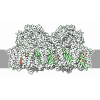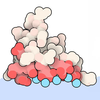[English] 日本語
 Yorodumi
Yorodumi- PDB-8ib7: Respiratory complex CIII2, focus-refined of type IA, Wild type mo... -
+ Open data
Open data
- Basic information
Basic information
| Entry | Database: PDB / ID: 8ib7 | |||||||||
|---|---|---|---|---|---|---|---|---|---|---|
| Title | Respiratory complex CIII2, focus-refined of type IA, Wild type mouse under cold temperature | |||||||||
 Components Components |
| |||||||||
 Keywords Keywords | ELECTRON TRANSPORT / Respiratory complex / Respiratory supercomplex | |||||||||
| Function / homology |  Function and homology information Function and homology informationresponse to D-galactosamine / Complex III assembly / response to mercury ion / Respiratory electron transport / subthalamus development / pons development / response to cobalamin / cerebellar Purkinje cell layer development / mitochondrial respiratory chain complex III assembly / pyramidal neuron development ...response to D-galactosamine / Complex III assembly / response to mercury ion / Respiratory electron transport / subthalamus development / pons development / response to cobalamin / cerebellar Purkinje cell layer development / mitochondrial respiratory chain complex III assembly / pyramidal neuron development / response to alkaloid / cellular respiration / Mitochondrial protein degradation / thalamus development / respiratory chain complex III / quinol-cytochrome-c reductase / response to glucagon / quinol-cytochrome-c reductase activity / response to copper ion / mitochondrial electron transport, ubiquinol to cytochrome c / hypothalamus development / midbrain development / electron transport coupled proton transport / animal organ regeneration / response to hyperoxia / response to cadmium ion / response to hormone / response to activity / respiratory electron transport chain / hippocampus development / response to calcium ion / metalloendopeptidase activity / 2 iron, 2 sulfur cluster binding / response to toxic substance / myelin sheath / response to ethanol / response to hypoxia / mitochondrial inner membrane / response to xenobiotic stimulus / heme binding / ubiquitin protein ligase binding / protein-containing complex binding / mitochondrion / proteolysis / nucleoplasm / metal ion binding / membrane Similarity search - Function | |||||||||
| Biological species |  | |||||||||
| Method | ELECTRON MICROSCOPY / single particle reconstruction / cryo EM / Resolution: 3.4 Å | |||||||||
 Authors Authors | Shin, Y.-C. / Liao, M. | |||||||||
| Funding support |  United States, 2items United States, 2items
| |||||||||
 Citation Citation |  Journal: Cell / Year: 2024 Journal: Cell / Year: 2024Title: Structural basis of respiratory complex adaptation to cold temperatures. Authors: Young-Cheul Shin / Pedro Latorre-Muro / Amina Djurabekova / Oleksii Zdorevskyi / Christopher F Bennett / Nils Burger / Kangkang Song / Chen Xu / Joao A Paulo / Steven P Gygi / Vivek Sharma / ...Authors: Young-Cheul Shin / Pedro Latorre-Muro / Amina Djurabekova / Oleksii Zdorevskyi / Christopher F Bennett / Nils Burger / Kangkang Song / Chen Xu / Joao A Paulo / Steven P Gygi / Vivek Sharma / Maofu Liao / Pere Puigserver /    Abstract: In response to cold, mammals activate brown fat for respiratory-dependent thermogenesis reliant on the electron transport chain. Yet, the structural basis of respiratory complex adaptation upon cold ...In response to cold, mammals activate brown fat for respiratory-dependent thermogenesis reliant on the electron transport chain. Yet, the structural basis of respiratory complex adaptation upon cold exposure remains elusive. Herein, we combined thermoregulatory physiology and cryoelectron microscopy (cryo-EM) to study endogenous respiratory supercomplexes from mice exposed to different temperatures. A cold-induced conformation of CI:III (termed type 2) supercomplex was identified with a ∼25° rotation of CIII around its inter-dimer axis, shortening inter-complex Q exchange space, and exhibiting catalytic states that favor electron transfer. Large-scale supercomplex simulations in mitochondrial membranes reveal how lipid-protein arrangements stabilize type 2 complexes to enhance catalytic activity. Together, our cryo-EM studies, multiscale simulations, and biochemical analyses unveil the thermoregulatory mechanisms and dynamics of increased respiratory capacity in brown fat at the structural and energetic level. | |||||||||
| History |
|
- Structure visualization
Structure visualization
| Structure viewer | Molecule:  Molmil Molmil Jmol/JSmol Jmol/JSmol |
|---|
- Downloads & links
Downloads & links
- Download
Download
| PDBx/mmCIF format |  8ib7.cif.gz 8ib7.cif.gz | 809.8 KB | Display |  PDBx/mmCIF format PDBx/mmCIF format |
|---|---|---|---|---|
| PDB format |  pdb8ib7.ent.gz pdb8ib7.ent.gz | Display |  PDB format PDB format | |
| PDBx/mmJSON format |  8ib7.json.gz 8ib7.json.gz | Tree view |  PDBx/mmJSON format PDBx/mmJSON format | |
| Others |  Other downloads Other downloads |
-Validation report
| Arichive directory |  https://data.pdbj.org/pub/pdb/validation_reports/ib/8ib7 https://data.pdbj.org/pub/pdb/validation_reports/ib/8ib7 ftp://data.pdbj.org/pub/pdb/validation_reports/ib/8ib7 ftp://data.pdbj.org/pub/pdb/validation_reports/ib/8ib7 | HTTPS FTP |
|---|
-Related structure data
| Related structure data |  35334MC 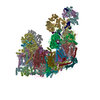 8iaoC 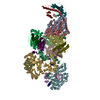 8iapC 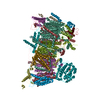 8iaqC 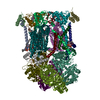 8iarC 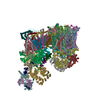 8ib4C  8ib5C 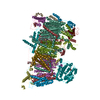 8ib6C  8ib9C 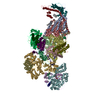 8ibaC 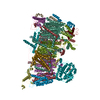 8ibbC  8ibcC  8ibdC 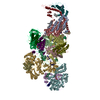 8ibeC 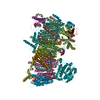 8ibfC  8ibgC  8ic2C  8ic3C 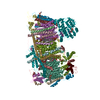 8ic4C 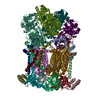 8ic5C 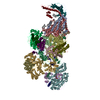 8xnlC 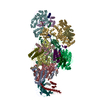 8xnmC 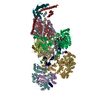 8xnnC 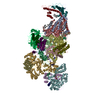 8xnoC 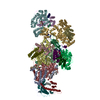 8xnpC 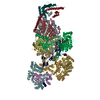 8xnqC 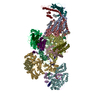 8xnrC 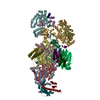 8xnsC 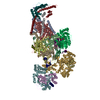 8xntC 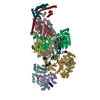 8xnuC 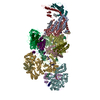 8xnvC 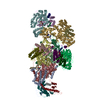 8xnwC  8xnxC  8xnyC  8xnzC  8xo0C M: map data used to model this data C: citing same article ( |
|---|---|
| Similar structure data | Similarity search - Function & homology  F&H Search F&H Search |
- Links
Links
- Assembly
Assembly
| Deposited unit | 
|
|---|---|
| 1 |
|
- Components
Components
-Cytochrome b-c1 complex subunit ... , 8 types, 17 molecules AAAaABAbAEAIAeAFAfAGAgAHAhAJAjAKAk
| #1: Protein | Mass: 52910.594 Da / Num. of mol.: 2 / Source method: isolated from a natural source / Source: (natural)  #2: Protein | Mass: 48289.730 Da / Num. of mol.: 2 / Source method: isolated from a natural source / Source: (natural)  #5: Protein | Mass: 29406.635 Da / Num. of mol.: 3 / Source method: isolated from a natural source / Source: (natural)  #6: Protein | Mass: 13587.532 Da / Num. of mol.: 2 / Source method: isolated from a natural source / Source: (natural)  #7: Protein | Mass: 9783.245 Da / Num. of mol.: 2 / Source method: isolated from a natural source / Source: (natural)  #8: Protein | Mass: 10452.694 Da / Num. of mol.: 2 / Source method: isolated from a natural source / Source: (natural)  #9: Protein | Mass: 7457.526 Da / Num. of mol.: 2 / Source method: isolated from a natural source / Source: (natural)  #10: Protein | Mass: 6546.627 Da / Num. of mol.: 2 / Source method: isolated from a natural source / Source: (natural)  |
|---|
-Protein , 2 types, 4 molecules ACAcADAd
| #3: Protein | Mass: 43240.305 Da / Num. of mol.: 2 / Source method: isolated from a natural source / Source: (natural)  #4: Protein | Mass: 35374.652 Da / Num. of mol.: 2 / Source method: isolated from a natural source / Source: (natural)  |
|---|
-Non-polymers , 7 types, 21 molecules 
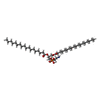
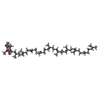

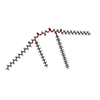

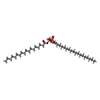






| #11: Chemical | ChemComp-HEM / #12: Chemical | ChemComp-3PE / #13: Chemical | #14: Chemical | #15: Chemical | ChemComp-CDL / #16: Chemical | #17: Chemical | |
|---|
-Details
| Has ligand of interest | Y |
|---|---|
| Has protein modification | Y |
-Experimental details
-Experiment
| Experiment | Method: ELECTRON MICROSCOPY |
|---|---|
| EM experiment | Aggregation state: PARTICLE / 3D reconstruction method: single particle reconstruction |
- Sample preparation
Sample preparation
| Component | Name: Respiratory Supercomplex CI:CIII2 / Type: COMPLEX / Entity ID: #1-#10 / Source: NATURAL |
|---|---|
| Molecular weight | Value: 1.32 MDa / Experimental value: NO |
| Source (natural) | Organism:  |
| Buffer solution | pH: 8 |
| Specimen | Conc.: 0.33 mg/ml / Embedding applied: NO / Shadowing applied: NO / Staining applied: NO / Vitrification applied: YES |
| Vitrification | Cryogen name: ETHANE |
- Electron microscopy imaging
Electron microscopy imaging
| Experimental equipment |  Model: Talos Arctica / Image courtesy: FEI Company | ||||||||||||
|---|---|---|---|---|---|---|---|---|---|---|---|---|---|
| Microscopy | Model: FEI TALOS ARCTICA | ||||||||||||
| Electron gun | Electron source:  FIELD EMISSION GUN / Accelerating voltage: 200 kV / Illumination mode: OTHER FIELD EMISSION GUN / Accelerating voltage: 200 kV / Illumination mode: OTHER | ||||||||||||
| Electron lens | Mode: OTHER / Nominal defocus max: 2200 nm / Nominal defocus min: 1000 nm | ||||||||||||
| Image recording |
|
- Processing
Processing
| CTF correction | Type: NONE |
|---|---|
| 3D reconstruction | Resolution: 3.4 Å / Resolution method: FSC 0.143 CUT-OFF / Num. of particles: 151188 / Symmetry type: POINT |
 Movie
Movie Controller
Controller





































 PDBj
PDBj



